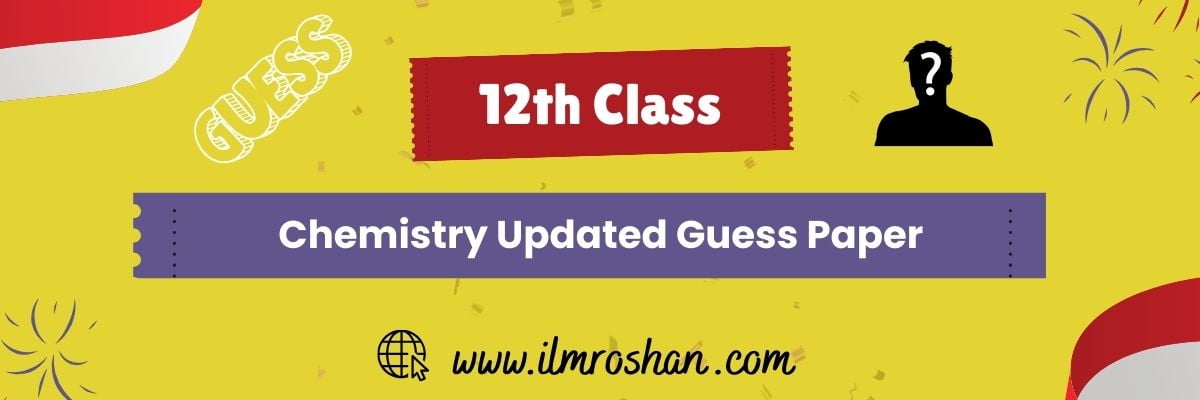The 2nd Year Chemistry Guess Paper 2025 Punjab Board is now available to help FSc Part 2 students prepare efficiently for their board exams. This guess paper is designed according to the latest syllabus and board paper trends, ensuring that students focus on the most important and frequently asked questions.
Chemistry can be a challenging subject due to its theoretical and numerical portions. With the help of this guess paper, students can target key questions, short exercises, and long questions expected in the 2025 annual exams.
2nd Year Chemistry Guess Paper 2025 Punjab Board Overview
| 2nd Year Chemistry Guess Paper 2025 – Overview | |
|---|---|
| Class | 12th Class (2nd Year) |
| Subject | Chemistry |
| Boards | All Punjab Boards |
| Academic Year | 2025 |
| Exam Type | Annual Examination |
| Paper Start Date | 29 April 2025 |

What’s Included in the 12th class Chemistry Guess Paper 2025?
This updated guess paper includes:
- Chapter-wise important short questions
- Expected long questions from key chapters
- Frequently asked numerical problems
- Important definitions and conceptual points
- High-priority MCQs selected from past papers
This guess paper is created by expert teachers to help students revise smartly without covering the entire book in random order.
Applicable Punjab Boards
The guess paper is valid for all Punjab Boards under BISE, including:
- BISE Lahore
- BISE Gujranwala
- BISE Faisalabad
- BISE Multan
- BISE Rawalpindi
- BISE Bahawalpur
- BISE Sahiwal
- BISE Sargodha
- BISE D.G. Khan
We are sharing Chemistry Guess Papers for 12th-grade students, which you can download for free from the ILM Roshan website. here you can see the
Latest 2nd Year Chemistry Guess Paper 2025 PDF Download
Why Use the 2nd Year Chemistry Guess Paper 2025?
- Focuses on most expected questions
- Saves revision time by narrowing the syllabus
- Ideal for last-minute preparation
- Helps in building exam confidence
If you want to score better in your Chemistry board exam, use this 2nd Year Chemistry Guess Paper 2025 Punjab Board with your textbook and pairing scheme for the best results.
2nd year chemistry pairing scheme Punjab board.
12th Class chemistry guess paper 2025 in text form:
here is the chemistry guess paper 2025 in text form:
Chapter: 1
Important Short Questions
- How does metallic character change within a group of metals?
- Define electron affinity and explain its trend in the periodic table.
- Why is hydrogen placed at the top of group VII-A elements?
- Explain why the hydration energy of Al³⁺ ion is higher than that of Mg²⁺ ion.
- Why do alkali metals form ionic hydrides?
- Name four uses of nitric acid.
- Highlight the differences between lithium and other members of its family.
- Justify why ionization energy increases from left to right in a period.
- What makes metals good conductors of electricity?
- Describe hydration energy with examples.
- Why is diamond a non-conductor while graphite is a good conductor?
- Why do anions tend to be larger than their parent atoms?
- What are the different types of hydrides?
- How does hydrogen resemble group IV-A elements?
Important Long Questions:
- Discuss the classification and characteristics of hydrides.
- Define the periodic table and discuss Mendeleev’s contributions to its improvement.
- Explore the trends in metallic character across groups and periods, considering the impact of atomic size.
Chapter 2
Important Short Questions:
- Provide the formulas for (i) Dolomite and (ii) Asbestos.
- Provide the formulas for Natron and Halite.
- How can ethanol and propanol be differentiated?
- What reactions occur when (i) lithium carbonate and (ii) sodium bicarbonate are heated?
- Identify two main problems faced by the diaphragm cell during operation.
- Why is Down’s cell preferred for mass production of sodium?
- How does hydrogen resemble alkali metals?
- Name two properties that lithium and magnesium share.
- Write the chemical formulas for Beryl and Barite.
- Give the formulas for borax and chili saltpeter.
Important Long Questions
- Explain the process of producing sodium metal using Down’s cell.
- Complete and balance the following equations: (i) Li₂O + H₂O, (ii) Na₂O + H₂O, (iii) Mg + (OH)₂, (iv) NaNO₃.
- Discuss the commercial-scale production of sodium hydroxide using diaphragm cell or Nelson cell.

Chapter 3
Important Short Questions
- List two uses of sodium silicate.
- How can borax be prepared from colemanite? Provide the equation.
- What is the borax bread test?
- How is borax utilized as a water-softening agent?
- Why are borate glazes preferred over silicate glazes?
- Name the oxides of nitrogen along with their formulas.
- What is carbonization?
- Describe the structure of CO₂.
- State four everyday uses of aluminium.
- Highlight two similarities between carbon and silicate.
- Explain the reactions of P₂O₅ with cold and hot water.
- Why is an aqueous solution of borax alkaline?
- Describe four uses of borax.
Important Long Questions:
- Describe the conversion of boric acid to borax and vice versa.
- Provide information on aluminium silicate.
- Explain the method of preparing glass and its various uses.
Chapter 4
Important Short Questions
- all the short questions from the exercises.
Chapter 5
Important Short Questions
- all the short questions from the exercises.
Chapter 6
Important Short Questions
- all the short questions from the exercises.
Important Long Questions
- Explain the properties of transition elements: i) Paramagnetism ii) Color.
- Discuss the concepts of: i) Binding energy ii) Paramagnetism.
Chapter 7
Important Short Questions
- Define octane number and suggest methods for its improvement.
- What is iodized salt?
- Why is ethane significant industrially?
- Define isomers and name four types.
- Explain functional groups and name oxygen-containing ones.
- Explain alicyclic and aromatic compounds.
- Define petroleum and its origin.
- Discuss the importance of ethane in industry.
- Explain coal tar and its constituents.
- Describe thermal and steam cracking.
- Define catenation and provide examples.
- Explain cis-trans isomerism.
- Define and exemplify tautomerism.
- Define organic chemistry.
- Give structural formulas for two isomers of C4H10.
- Describe major sources of organic compounds.
- Define catalytic cracking.
- Differentiate between homocyclic and heterocyclic compounds.
Important Long Questions
- Define Isomerism and its types.
- What is orbital hybridization? Define sp³, sp², and sp hybridization modes.
- Detail the process of petroleum cracking.
Chapter 8
Important Short Questions
- How are cis and trans alkenes formed?
- Convert ethane to ethyl alcohol.
- Explain hydrogenolysis.
- Convert methane to formic acid.
- Discuss why alkanes are less reactive than alkenes.
- Convert ethane to acetaldehyde.
- What is Markonikov’s principle?
- Elaborate on the acidity of ethyne.
- Convert methane to formic acid.
- Convert 1-butane to 1-butene.
- Enumerate four uses of methane.
- Synthesize: i. benzene ii. oxalic acid from ethane.
- Define Raney-Nickel and state its uses.
- Describe Beer’s test and its applications.
- Distinguish between ethane and ethene.
- Why is a π bond more reactive than a σ bond?
Important Long Questions
- Compare the reactivity of alkanes, alkenes, and alkynes.
- Explain the acidic nature of alkynes with examples.
- Provide chemical reactions of ethane with i) O2 in the presence of Ag2O ii) Conc. H2SO4 iii) S2Cl2 iv) HOCl.
Chapter 9
Important Short Questions
- Provide the reaction of benzene with electrophiles.
- Illustrate the cyclic structure of benzene with a diagram.
- Define aromatization.
- Give the reaction of benzene with SO3.
- Prepare benzene from: i. n-hexane ii. Sodium benzoate.
- Explain the mechanism of nitration of benzene.
- Why is benzene less reactive than alkanes?
- Define electrophile and give two examples.
- Give the reaction of benzene with ozone (ozonolysis).
- How is benzene converted to malic acid via catalytic oxidation?
- Explain aromatic compounds.
- What is the Wurts fitting reaction and its importance?
- List two oxidation reactions of benzene.
- Define fused ring aromatic compounds.
- Summarize X-ray studies on the structure of benzene.
Important Long Questions
- Outline four chemical methods for preparing benzene.
- Convert benzene to: i) Cyclohexane ii) Maleic acid.
- Describe the reactions of benzene regarding: i) Nitration ii) Sulphonation.
- Explain Friedel-Crafts reactions and the mechanisms of benzene alkylation and acylation.
Chapter 10
Important Short Questions
- What are alkyl halides? Provide their general formula.
- Explain the Grignard reagent.
- Compare SN1 and SN2 mechanisms.
- Explain Markovnikov’s principle with a suitable example.
- Starting from C2H4Br, how would you prepare ethane and ethene?
- Discuss the reaction: CH4 → CH3CH2COOH.
- How do we obtain alkyl nitriles from the Grignard reagent?
- Define elimination reactions and give an example of an E1 reaction.
- Enumerate the types of nucleophilic substitution reactions.
- Convert ethyl alcohol to respective halides using PCl3 and PI5.
- Define Wurtz reaction.
- What are primary, secondary, and tertiary alkyl halides? Provide an example of each.
Important Long Questions
- Explain β elimination reaction E2 with an example.
- Discuss the mechanism of nucleophilic substitution reactions.
- Describe SN2 reaction of alkyl halides in detail.
- How can the presence of a double bond be detected using Baeyer’s reagent?
Chapter 11
Important Short Questions
- Write the equation for the reaction of C2H5OH with PBr3, PCl5.
- Convert methanol to ethanol and acetone to ethyl alcohol.
- What is the Lucas test?
- Write the structural formula of: a) Carbolic acid b) Glycerol.
- Define rectified spirits, commercial alcohol, and absolute alcohol.
- Why is the boiling point of water higher than that of ethanol?
- State the uses of ethyl alcohol and methyl alcohol.
- Explain why ethyl alcohol is a liquid while methyl chloride is a gas.
- Provide names and formulas of two polyhydric alcohols.
- Convert methanol to ethanol.
- Define fermentation and its terms.
- Why can’t absolute alcohol be produced by fermentation?
- Define wood spirit and explain its production from water gas.
- Differentiate between primary and secondary alcohols.
Important Long Questions
- What is ether? Give its reaction.
- Explain i) Esterification and ii) Sulphonation.
- How are alcohols produced? Explain their properties and uses.
Chapter 13
Important Short Questions
- List four uses of acetic acid.
- Define aromatic carboxylic acids.
- Explain the mechanism of esterification of carboxylic acids.
- Define essential and non-essential amino acids.
- Describe the conversion of ethanol to acetic acid and vice versa.
- Define protein and differentiate it from polypeptides.
- Define fatty acids and provide examples.
- What is the composition of streaker?
- Enumerate four uses of nitric acid.
- How can carboxylic acid be converted into amino acid?
- Define peptides and peptide linkage.
- Explain the ninhydrin test.
- Explain Zwitter ions with an equation.
- How would you prepare acetic acid from ethene?
- Name five dicarboxylic acids and provide their formulas.
Chapter 14
- Provide the structure of cholesterol.
- Explain: i) Protein ii) Lipids iii) Polymer.
- Describe the manufacture of polystyrene and its two uses.
- List the uses of proteins.
- Define carbohydrates, classify them, and give an example of each.
- Define saponification number and iodine number.
- Define fatty acids and give examples.
- How are polymers classified based on heat effect?
Chapter 15 and Chapter 16:
- Name the steps in the papermaking process.
- Define urea filtration.
- What reaction occurs in the decomposition zone during cement manufacturing?
- What type of wood raw material is used in the paper industry?
- Define macronutrients.
- Compare SN1 and SN2 mechanisms.
- Why is fertilizer needed?
- Define urea filtration.
- What is cement setting?
- Explain the role of phosphorus in plant growth.
- Discuss the role/importance of potassium in plant growth.
- Name some bleaching agents commonly used in papermaking.
- Define clinker and explain its use in cement manufacturing.
- Discuss the role of chlorofluorocarbons in ozone depletion.
Important Note:
Remember that 2nd-year chemistry Guess papers are the most important questions for the annual exam and should not be relied upon completely. They can be used as a guide to focus on important topics.
Subject Wise 12th Class Guess Paper—Punjab Board
Important questions for annual exams preparation

Hi, Yasrab Ali Qazi Here!
“Founder & CEO of ILM Roshan Institute 📚 | Educational Expert 🎓 | Digital Creator 💻”
Empowering students and professionals with quality educational resources, exam preparation, job updates, and career guidance. Unlock success with ILMRoshan.com! 🚀✨


